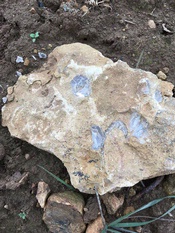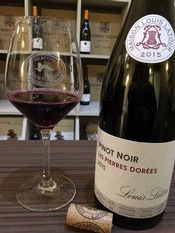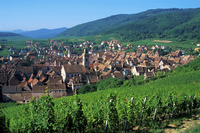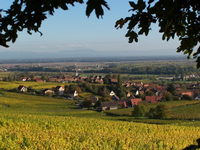|
|
 |
|
November 27, 2016
Everyone knows THE grape in Beaujolais is Gamay. Ok, a little Chardonnay, which finds its way
into Beaujolais Blanc or even Bourgogne Blanc, is planted in the region as
well. But now, a game-changer could transform
and revitalize the region--a major Burgundian producer has started planting and
making wine from Pinot Noir in Beaujolais.
And the first vintage of it is very appealing. 
Maison Louis Latour, one of Burgundy’s top producers, took
the plunge in 2012 and planted about 45 acres of Pinot Noir in southern
Beaujolais, in an area known as the Pierres Dorées because of the golden color
of the limestone rocks there. Emeric
Teyssou, who oversees the viticulture for Latour, notes that the soil in the
Pierres Dorées is different from the remainder of Beaujolais where volcanic
granite prevails. Here, it’s more a marl
limestone mixture similar to that found in the Côte d’Or. It is abundantly clear that in prehistoric
times the land in this area was under a vast sea because everywhere you look
there are shell-like fossils in the stones.
There was one small, less than 2-acre parcel, that had been
planted with Pinot Noir in the 1970s, which Latour kept, but the remaining
parcels were replanted in a Burgundian fashion, more suitable for Pinot Noir
than Gamay. Most importantly, the new
vines were trained on wires instead of the traditional gobelet system used for Gamay.
Immediately after harvest, the Pinot Noir grapes are kept
cold and delivered by truck to the Latour winery in Beaune, a trip that takes
only about one and a quarter hours.
Vinification is similar to Latour’s other red Burgundies. Latour made only a few thousand bottles of
the 2015, not enough to be imported into the U.S. Although exact quantities of the 2016 have
not been determined because the wine is still aging, Latour estimates they will
produce about 30,000 bottles, which means that some will come to our shores.
 The wine is bottled under a relatively new appellation,
Côteaux Bourguignons, which allows any blend of Pinot Noir and Gamay, along with
some other minor grapes, grown throughout Burgundy, including Beaujolais. (Côteaux Bourguignons will replace the
terrible sounding appellation, Bourgogne Grand Ordinaire, and Bourgogne
Passetoutgrains, which currently allows the blending the Pinot Noir and Gamay.) The wine is bottled under a relatively new appellation,
Côteaux Bourguignons, which allows any blend of Pinot Noir and Gamay, along with
some other minor grapes, grown throughout Burgundy, including Beaujolais. (Côteaux Bourguignons will replace the
terrible sounding appellation, Bourgogne Grand Ordinaire, and Bourgogne
Passetoutgrains, which currently allows the blending the Pinot Noir and Gamay.)
The 2015 Maison Louis Latour Pinot Noir “Les Pierres Dorées” is
a smashing success, delivering juicy fruity notes buttressed by round mild
tannins and a hint of savory, earthy notes.
It’s a perfect “roast chicken” kind of wine. I can’t wait for the 2016 version to hit our
shores….
Posted by Michael Apstein at 10:16 AM
|
|
November 16, 2016
The one thing I know about you for sure is that you read wine websites, and that gives me very good odds of being correct about one other thing: You are probably the most wine-knowledgeable person attending your meat for Thanksgiving next week, and in turn, that probably means you’re responsible for bringing the wine.
If you plan to take that responsibility seriously, you’d do well to press past the many particular recommendations being offered at the moment to consider why certain wines work much better with this meal than others. Although that may sound like more work than you need right during this busy season, you’ll actually be freed up by learning some pairing principles, as they’ll enable you to select from a very wide range of wines with strong assurance of success.
I’ll list some particular wine types that you could consider for this year’s meal, but for now, here are some important background considerations:
1) Turkey’s flavor is relatively subtle, so wines with a lot of intensity and power can overwhelm it. Different preparations count, though, such as smoking the bird, but this is still not a meal suited to overly pushy wines.
2) Most households will have wine novices at the table, so intense wines are doubly inadvisable, as are tannic ones. Tannic wines also don’t work well because there’s not a lot of dietary fat in most turkey preparations, even though some people put lots of butter into side dishes like mashed potatoes.
3) Although really big wines don’t make sense with this meal, don’t go too small. Dark meat with gravy is much more robust than white meat without gravy, so quite light wines like Sauvignon Blanc or Pinot Grigio could be overwhelmed. This is a very important factor because some diners much prefer dark or light meat, and these preferences don’t always coincide with preferences for red or white wine.
4) Many households with large gatherings will include guests who much prefer either whites or reds, so including one of each is wise, even if as few as 4 are around the table.
5) Medium body and moderate robustness is the right road to success, and avoiding any characteristics that are sharply prominent (e.g., acidity, wood, sweetness, tannin) is important because of the complexity of the meal.
6) This complexity stems mostly from the side dishes, which matter…a lot. Cranberries are usually tart or sweet or both. Sweet potatoes are … um… sweet. Mashed potatoes are rich. Stuffing is too, almost regardless of the components. Green vegetables can range from pungent to bright. The only wines that can succeed with everything on a typical plate are thus integrated as well as medium bodied and moderately intense.
7) Integration can result from the character of the grape variety (e.g., Pinot Blanc) or from cellar techniques used or eschewed (malolactic fermentation to smooth out acidity, or wood ageing avoided to retain roundness and primary fruit). It can also result from ageing in reds, which softens tannin and leads to absorption of wood notes. However, the wine needs to have started its development with relatively acidity if it is to achieve integration from ageing without losing refreshment value. So, a cool climate Syrah from the northern Rhône can work well, but an aged Shiraz from Australia isn’t a great choice.
8) Although this isn’t a particularly fatty meal, it invariably ends up leaving everyone very full…if not downright comatose from tryptophan. So, successful wines always have some refreshment value, regardless of whether white or red. This is almost always stems from acidity, which in turn is almost always geographically associated with relatively cool climates. So, pick wines from a cool region, or ask a wine consultant in a retail shop to help you do that.
9) To help your guests perk up their appetites (and retain consciousness over the course of the meal), welcome them with very light wine. Sparkling wines make excellent aperitifs on any occasion, and are particularly appropriate for a celebration, but pick light ones. Rosé sparklers can be very good with the meal, but lighter Blanc de Blancs bottles are much better for starters. Regarding other before-dinner drinks, beer is filling and cocktails are befogging (and also enhance the likelihood of family fights). Nevertheless, hospitality requires that we accede to requests…even when based on bad ideas.
10) “Light is Right” holds equally true at the end of the meal. Finishing the dinner with something fresh and relatively light (like Riesling Auslese from Germany) is a better idea than Port, but if the dessert demands, Tawny is a much better choice than LBV or Vintage. However, if you have guests who want a Port or a Cognac after the meal, just be sure to have a sufficient number of guest rooms, couches or air mattresses to accommodate those who keel over.
Particularly Successful Whites:
Riesling (dry or barely sweet; Alsace, Austria, or German Trocken)
Pinot Blanc (a.k.a. Pinot Bianco from Italy or Weissburgunder from Germany)
Chasselas
Chenin Blanc (South African renditions are particularly suitable)
Silvaner
Prosecco / Glera
Albariño
Ribola Gialla (especially from Collio in northeastern Italy)
Godello
Friulano
Grüner Veltliner
Moschofilero )from Greece)
Roussanne and/or Marsanne
Particularly Successful Reds:
Pinot Noir (especially from Burgundy)
Grenache
Tempranillo (but not too oaky)
Sangiovese
Zweigelt (from Austria)
Blaufrankisch (from Austria)
St. Laurent (no kidding…Austrian reds rock with this meal!)
Dolcetto
Gamay (Cru Beaujolais, please)
Nebbiolo (young from Langhe appellation, not Barolo or Barbaresco)
Nero d’Avola
Cab Franc, specifically, Chinon or Bourgueil from the Loire
Agiorghitiko (a.k.a. St. George, from the northern Peloponnese in Greece)
Posted by Michael Franz at 3:50 PM
|
|
November 2, 2016
For the first decade of my work as a wine writer, I probably devoted more columns in The Washington Post to Riesling from Alsace than any other grape from any other region. I believed then--as I do now--that Riesling was the world’s greatest white wine grape variety, for a whole slew of reasons. However, the general wine consuming public never really took  to Riesling, and I made it my business to tell them repeatedly that they were missing out on something fabulously delicious and food-friendly. to Riesling, and I made it my business to tell them repeatedly that they were missing out on something fabulously delicious and food-friendly.
Riesling is grown and vinified in many places around the world, but from the mid-1994 until 2005, when I was writing for the Post before leaving to help launch Wine Review Online, Alsace was the primo place of origin for someone like me who was bent on hooking readers on Riesling. German renditions were marvelous but dauntingly complicated and often too sweet for most consumers to use without specific pairing instructions. Austrian Rieslings were just becoming available. Australia made great Rieslings, but nobody here was interested in anything but Shiraz, so importers rarely brought the wines to our shores.
Washington and Oregon were just cranking up production, as were the Canadians in British Columbia and Ontario (all of which are now making wonderful Rieslings, along with Michigan and New York’s Finger Lakes). California Rieslings could be found fairly easily, but most of them were pretty boring, as there’s just too much sun and heat in most of the Golden State to make the sleek, zesty style that most effectively lures wine lovers into Riesling World.
That left Alsace, which made reasonably priced wines that were essentially dry, widely available, fairly priced, and terrific with all sorts of  foods. This last virtue made them my “go-to” whites for Thanksgiving, and I never let a year go by without using that national occasion to preach the Alsace Riesling gospel. foods. This last virtue made them my “go-to” whites for Thanksgiving, and I never let a year go by without using that national occasion to preach the Alsace Riesling gospel.
But then, about a decade ago, things took multiple turns, and not in good directions for Rieslings from Alsace. Dry Rieslings started appearing in serious numbers from Germany, partly because of a change in drinking fashions in that nation, and partly due to climate change lowering acidity and lowering the need for sugar to balance it. Weirdly, many winemakers in Alsace started leaving more sugar in their Rieslings even as the Germans were moving in the opposite direction, which was a bad move both commercially and stylistically, in my opinion. Austria started sending a lot of dry or barely off-dry renditions, and this is also when Rieslings from Washington, Oregon, Canada, New York and Australia got a lot better and a lot easier to find.
To be sure, exemplary producers like Trimbach never strayed from dry style Rieslings, nor did they ever miss a beat on quality. But the category of Alsace Riesling as a whole slipped badly, moving from a commanding position to just another choice among many, and a dicey choice at that, since the sweetness one would get from any particular bottle was no longer a predictable matter.
I honestly do not know how much this decline from “indispensable” to “also ran” actually hurt vintners' bottom lines in Alsace, where tourism tends to prop everything up. But I do know that--somehow--the message got through, as Rieslings from Alsace have become notably drier and more consistently excellent in the past few years.
With Thanksgiving now around the corner, the time seems right to profile some strong cases in point. As a teaser, here are five fine bottlings, with more to come in my next column two weeks from now. As you work down the list, the wines will get better as you go, and the ones I’m saving for the column are the best of the best, so be sure to revisit WRO in two weeks:
Domaine Loew (Alsace) Riesling “Muschelkalck” 2012 ($20): I have virtually no experience with this producer’s wines, despite having spent a lot of time in Alsace, but I’ll have an eye peeled from now on. This shows some lovely floral topnotes, followed by taut fruit and a finish that recalls wet stones and oyster shells. Fresh and fun, but with some complexity too. 90
Meyer-Fonné (Alsace) Riesling Réserve 2013 ($25): This is a fine example of the very welcome trend in Alsace toward rendering Rieslings  in a dry, fresh style. The aromas show a bit of positive development with light floral notes, but the palate is flinty and mineral and almost steely. A very energetic wine with lots of linear thrust (as opposed to creamy breadth), this is a very appealing choice for freshwater fish dishes. 91 in a dry, fresh style. The aromas show a bit of positive development with light floral notes, but the palate is flinty and mineral and almost steely. A very energetic wine with lots of linear thrust (as opposed to creamy breadth), this is a very appealing choice for freshwater fish dishes. 91
Gustave Lorentz (Alsace) Riesling Grand Cru Altenburg de Bergheim Riesling 2008 ($60): This house has been on the upswing in recent years, and 2008 was an excellent vintage that shows the boost phase of the ascent. The wine is now probably fully developed, but is at a wonderful stage at the moment, showing just a pleasant whiff of petrol on the nose, but with fruity and flowery scents as well. Rich and rounded but still structured by nice acidity, this is opulent enough to work beautifully with richer fish dishes, turkey and stuffing with gravy, or even slow-cooked pork. 91
Paul Blanck (Alsace) Riesling Grand Cru Schlossberg 2012 ($38): Conspicuously rich, with lots of mandarin and some light tropical notes, this is a big wine for an Alsace Riesling, and yet it is nearly as graceful as it is impressive. Mineral tinges and other nuances emerge as one re-tastes this, and I suspect the wine’s sheer size obscures this layered character at first blush. 91
Josmeyer (Alsace) Grand Cru Brand 2012 ($70): A very lean, fresh expression of Alsace Riesling with a very low 3 grams per liter of residual sugar, this is a bit tight for the moment, but a very classy wine for pairing with lighter seafood dishes now (or somewhat more robust foods after it loosens up and fills out in the many years of positive development that lie ahead for it). 92
Posted by Michael Franz at 6:32 PM
|
|
 |
|